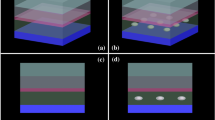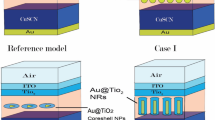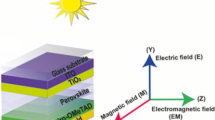Abstract
This paper proposes a novel design of plasmonic perovskite solar cell (PSC). It consists of an anti-reflective glass of fluorine-doped tin oxide (FTO), a compact buffer layer of n-type titanium dioxide (TiO2), an absorbing thin-film layer of perovskite (MAPbI3) integrated with gold (Au) nanospheres, a layer of p-type doped spiro-OMeTAD, and a layer of the cathode on aluminum (Al). This multilayer design’s primary purpose is to allow the light to enter the PSC with the minimum reflection and trap it in the active layer due to the presence of Au nanospheres. In this layer, the higher efficiency of PSC is achieved by localized surface plasmon resonances (LSPRs) in the wavelength range from 300 to 1100 nm. A reflective Al layer is used at the bottom of the device to reflect the light into the upper layers to considerably enhance the PSC absorption. The three-dimensional finite-difference time-domain method was conducted to find the best solution to Maxwell’s equations so that the best thickness and radius can be selected for each layer and Au nanospheres, respectively. Proper physical dimensions and Au nanospheres played a significant role in numerically indicating that the proposed structures are 60% more absorbent than the other conventional PSCs. In-house simulation software is used to approximate the solar cell by applying the finite element method to develop solutions for the drift–diffusion and Poisson’s equations. The examinations of the previous studies revealed that the current study is the first study that has simulated the real model of Auger recombination in perovskite. The results indicated that the proposed PSC embedded with Au nanospheres has the following properties: the built-in potential of 3.16 V, short-circuit current of 27.97 mA/cm2, the open-circuit voltage of 1 V, maximum power of 24.84 mW/cm2, fill-factor of 0.88, the conduction band of 3 eV, electron quasi-Fermi level of 2.5 eV, the hole quasi-Fermi level of 0.6 eV, and efficiency of 24.84%. Finally, the suggested PSC has performed 62% more efficient than conventional PSCs.











Similar content being viewed by others
References
Ikhmayies S (2018) Advances in silicon solar cells. Jenny Stanford Publishing
Singh G, Verma SS (2019) Design and analysis of thin film GaAs solar cells using silver nanoparticle plasmons. Photonics Nanostruct Fundam Appl 37:100731. https://doi.org/10.1016/j.photonics.2019.100731
Singh G, Verma SS (2019) Plasmon enhanced light trapping in thin film GaAs solar cells by Al nanoparticle array. Phys Lett A 383:1526–1530. https://doi.org/10.1016/j.physleta.2019.02.008
Tabrizi AA, Pahlavan A (2020) Efficiency improvement of a silicon-based thin-film solar cell using plasmonic silver nanoparticles and an antireflective layer. Opt Commun 454:124437. https://doi.org/10.1016/j.optcom.2019.124437
Arisman (2014) Nitric Oxide Chemistry and Velocity Slip Effects in Hypersonic Boundary Layers
Kosyachenko LA (2011) Solar Cells: Silicon Wafer-Based Technologies. BoD–Books on Demand
Lee TD, Ebong AU (2017) A review of thin film solar cell technologies and challenges. Renew Sustain Energy Rev 70:1286–1297
Girtan M (2012) Comparison of ITO/metal/ITO and ZnO/metal/ZnO characteristics as transparent electrodes for third generation solar cells. Sol Energy Mater Sol Cells 100:153–161. https://doi.org/10.1016/j.solmat.2012.01.007
Cardinaletti I, Vangerven T, Nagels S et al (2018) Organic and perovskite solar cells for space applications. Sol Energy Mater Sol Cells 182:121–127. https://doi.org/10.1016/j.solmat.2018.03.024
Barnham KWJ, Ballard IM, Browne BC et al (2010) Recent progress in quantum well solar cells. Nanotechnology for Photovoltaics 511:187–210. https://doi.org/10.1201/9781420076752
Wei J, Jia Y, Shu Q et al (2007) Double-walled carbon nanotube solar cells. Nano Lett 7:2317–2321. https://doi.org/10.1021/nl070961c
Yan J, Saunders BR (2014) Third-generation solar cells: A review and comparison of polymer:fullerene, hybrid polymer and perovskite solar cells. RSC Advances 4:43286–43314. https://doi.org/10.1039/c4ra07064j
Peng K, Wang X, Lee ST et al (2008) Silicon nanowire array photoelectrochemical solar cells. Appl Phys Lett 92:163103. https://doi.org/10.1063/1.2909555
Chien SC, Chenb FC (2013) Polymer solar cells. Polymer Electronics 6:179–222. https://doi.org/10.4032/9789814364041
Zarei K, Emami F (2020) Absorption enhancement and efficiency improvement of an organic solar cell embedded with core–shell Au@ITO nanoparticles. Opt Quant Electron 52:275. https://doi.org/10.1007/s11082-020-02401-w
Peter LM (2007) Dye-sensitized nanocrystalline solar cells. Phys Chem Chem Phys 9:2630–2642. https://doi.org/10.1039/b617073k
Ameta R, Benjamin S, Sharma S, Trivedi M et al (2015) Dye-sensitized solar cells. Solar Energy Conversion and Storage: Photochemical Modes 10:85–113
Nazeeruddin MK, Baranoff E, Grätzel M et al (2011) Dye-sensitized solar cells: a brief overview. Sol Energy 85:1172–1178. https://doi.org/10.1016/j.solener.2011.01.018
Ding IK, Zhu J, Cai W et al (2011) Plasmonic dye-sensitized solar cells. Adv Energy Mater 1:52–57. https://doi.org/10.1002/aenm.201000041
Mathew S, Yella A, Gao P et al (2014) Dye-sensitized solar cells with 13% efficiency achieved through the molecular engineering of porphyrin sensitizers. Nat Chem 6:242–247. https://doi.org/10.1038/nchem.1861
Zhao J, Li Y, Yang G et al (2016) Efficient organic solar cells processed from hydrocarbon solvents. Nat Energy 1:15027. https://doi.org/10.1038/NENERGY.2015.27
Hoppe H, Sariciftci NS (2004) Organic solar cells: an overview. J Mater Res 19:1924–1945. https://doi.org/10.1557/JMR.2004.0252
Ke W, Kanatzidis MG (2019) Prospects for low-toxicity lead-free perovskite solar cells. Nat Commun 10:965. https://doi.org/10.1038/s41467-019-08918-3
Jiang Q, Zhao Y, Zhang X et al (2019) Surface passivation of perovskite film for efficient solar cells. Nat Photonics 13:460–466. https://doi.org/10.1038/s41566-019-0398-2
Correa-Baena JP, Saliba M, Buonassisi T et al (2017) Promises and challenges of perovskite solar cells. Science 358:739–744. https://doi.org/10.1126/science.aam6323
Hwang T, Cho D, Kim J et al (2016) Investigation of chlorine-mediated microstructural evolution of CH3NH3PbI3(Cl) grains for high optoelectronic responses. Nano Energy 25:91–99. https://doi.org/10.1016/j.nanoen.2016.04.044
Nanova D, Kast AK, Pfannmöller M et al (2014) Unraveling the nanoscale morphologies of mesoporous perovskite solar cells and their correlation to device performance. Nano Lett 14:2735–2740. https://doi.org/10.1021/nl5006838
Handa T, Yamada T, Kubota H et al (2017) Photocarrier recombination and injection dynamics in long-term stable lead-free CH3NH3SnI3 perovskite thin films and solar cells. J Phys Chem C 121:16158–16165. https://doi.org/10.1021/acs.jpcc.7b06199
Yue L, Yan B, Attridge M, Wang Z et al (2016) Light absorption in perovskite solar cell. Sol Energy 124:143–152. https://doi.org/10.1016/j.solener.2015.11.028
Guarnera S, Abate A, Zhang W et al (2015) Improving the long-term stability of perovskite solar cells with a porous Al2O3 buffer layer. J Phys Chem Lett 6:432–437. https://doi.org/10.1021/jz502703p
Park JH, Seo J, Park S et al (2015) Efficient ch3nh3pbi3 perovskite solar cells employing nanostructured p-type NiO electrode formed by a pulsed laser deposition. Adv Mater 27:4013–4019. https://doi.org/10.1002/adma.201500523
Son D-Y, Im J-H, Kim H-S, Park N-G et al (2014) 11% efficient perovskite solar cell based on ZnO nanorods: an effective charge collection system. J Phys Chem C 118:16567–16573
Zhang P, Wu J, Zhang T et al (2018) Perovskite Solar Cells with ZnO Electron-Transporting Materials. Adv Mater 30:1703737. https://doi.org/10.1002/adma.201703737
Wang JTW, Ball JM, Barea EM et al (2014) Low-temperature processed electron collection layers of graphene/TiO 2 nanocomposites in thin film perovskite solar cells. Nano Lett 14:724–730. https://doi.org/10.1021/nl403997a
Kim HS, Lee JW, Yantara N et al (2013) High efficiency solid-state sensitized solar cell-based on submicrometer rutile TiO2 nanorod and CH3NH3PbI3 perovskite sensitizer. Nano Lett 13:2412–2417. https://doi.org/10.1021/nl400286w
Navab AA, Nemati A, Navab AA, Abad HMM et al (2018) Hydrothermal synthesis of TiO2 nanorod for using as an electron transport material in perovskite solar cells. AIP Conference Proceedings AIP Publishing LLC 1920(1):20015
Tan H, Santbergen R, Smets AHM, Zeman M et al (2012) Plasmonic light trapping in thin-film silicon solar cells with improved self-assembled silver nanoparticles. Nano Lett 12:4070–4076. https://doi.org/10.1021/nl301521z
Jensen TR, Malinsky MD, Haynes CL, Van Duyne RP et al (2002) Nanosphere Lithography: Tunable Localized Surface Plasmon Resonance Spectra of Silver Nanoparticles. J Phys Chem B 104:10549–10556. https://doi.org/10.1021/jp002435e
Vincenzo A, Roberto P, Marco F et al (2017) Surface plasmon resonance in gold nanoparticles: a review. J Phys: Condens Matter 29:203002
Poortmans J, Arkhipov V (2006) Thin Film Solar Cells: Fabrication, Characterization and Applications (Wiley Series in Materials for Electronic & Optoelectronic Applications). John Wiley & Sons
Noufi R, Zweibel K (2007) High-efficiency CdTe and CIGS thin-film solar cells: Highlights and challenges. In: Conference Record of the 2006 IEEE 4th World Conference on Photovoltaic Energy Conversion, WCPEC-4. IEEE, pp 317–320
Bergenek K, Wiesmann C, Wirth R et al (2008) Enhanced light extraction efficiency from AlGaInP thin-film light-emitting diodes with photonic crystals. Appl Phys Lett 93:41105. https://doi.org/10.1063/1.2963030
Lo Savio R, Miritello M, Shakoor A et al (2013) Enhanced 154 μm emission in Y-Er disilicate thin films on silicon photonic crystal cavities. Opt Express 21:10278. https://doi.org/10.1364/oe.21.010278
Zhang H, Cheng J, Lin F et al (2016) Pinhole-free and surface-nanostructured niox film by room-temperature solution process for high-performance flexible perovskite solar cells with good stability and reproducibility. ACS Nano 10:1503–1511. https://doi.org/10.1021/acsnano.5b07043
Edwards D (1997) Gallium Selenide (GaSe). Academic press
Ghosh G (1998) Handbook of Thermo-Optic Coefficients of Optical Materials with Applications. Academic Press
Würfel P, Würfel U (2009) Physics of solar cells: from basic principles to advanced concepts, second updated and expanded edition. John Wiley & Sons
Böer KW (1979) The physics of solar cells. World Scientific Publishing Company
Osterwald CR, McMahon TJ (2009) History of accelerated and qualification testing. Prog Photovolt: Res Appl 17:11–33. https://doi.org/10.1002/pip
Saghaei H, Van V (2019) Broadband mid-infrared supercontinuum generation in dispersion-engineered silicon-on-insulator waveguide. J Opt Soc Am B 36:A193. https://doi.org/10.1364/josab.36.00a193
Ghanbari A, Kashaninia A, Sadr A, Saghaei H et al (2018) Supercontinuum generation with femtosecond optical pulse compression in silicon photonic crystal fibers at 2500 nm. Opt Quant Electron 50(11):411. https://doi.org/10.1007/s11082-018-1651-5
Hosseinzadeh Sani M, Ghanbari A, Saghaei H et al (2020) An ultra-narrowband all-optical filter based on the resonant cavities in rod-based photonic crystal microstructure. Opt Quant Electron 52:295. https://doi.org/10.1007/s11082-020-02418-1
Sani MH, Tabrizi AA, Saghaei H, Karimzadeh R et al (2020) An ultrafast all-optical half adder using nonlinear ring resonators in photonic crystal microstructure. Opt Quant Electron 52:107. https://doi.org/10.1007/s11082-020-2233-x
Hosseinzadeh Sani M, Saghaei H, Mehranpour MA, Asgariyan Tabrizi A et al (2020) A novel all-optical sensor design based on a tunable resonant nanocavity in photonic crystal microstructure applicable in MEMS accelerometers. Photonic Sensors. https://doi.org/10.1007/s13320-020-0607-0
Saghaei H, Ebnali-Heidari M, Moravvej-Farshi MK et al (2015) Midinfrared supercontinuum generation via As_2Se_3 chalcogenide photonic crystal fibers. Appl Opt 54:2072. https://doi.org/10.1364/ao.54.002072
Saghaei H, Moravvej-Farshi MK, Ebnali-Heidari M, Moghadasi MN et al (2016) Ultra-wide mid-infrared supercontinuum deneration in As40Se60 chalcogenide fibers: solid core PCF versus SIF. IEEE J Sel Top Quantum Electron 22(2):279–286. https://doi.org/10.1109/JSTQE.2015.2477048
Diouf M, Ben SA, Cherif R et al (2017) Super-flat coherent supercontinuum source in As_388Se_612 chalcogenide photonic crystal fiber with all-normal dispersion engineering at a very low input energy. Appl Opt 56:163. https://doi.org/10.1364/ao.56.000163
Saghaei H (2018) Dispersion-engineered microstructured optical fiber for mid-infrared supercontinuum generation. Appl Opt 57:5591. https://doi.org/10.1364/ao.57.005591
Saghaei H, Zahedi A, Karimzadeh R, Parandin F et al (2017) Line defects on photonic crystals for the design of all-optical power splitters and digital logic gates. Superlattices Microstruct 110:133–138. https://doi.org/10.1016/j.spmi.2017.08.052
Kalantari M, Karimkhani A, Saghaei H et al (2018) Ultra-Wide mid-IR supercontinuum generation in As2S3 photonic crystal fiber by rods filling technique. Optik 158:142–151. https://doi.org/10.1016/j.ijleo.2017.12.014
Ebnali-Heidari M, Saghaei H, Koohi-Kamali F et al (2014) Proposal for supercontinuum generation by optofluidic infiltrated photonic crystal fibers. IEEE J Sel Top Quantum Electron 20(5):582–589. https://doi.org/10.1109/JSTQE.2014.2307313
Saghaei H (2017) Supercontinuum source for dense wavelength division multiplexing in square photonic crystal fiber via fluidic infiltration approach. Radioengineering 26:16–22. https://doi.org/10.13164/re.2017.0016
Naghizade S, Saghaei H (2020) A novel design of all-optical 4 to 2 encoder with multiple defects in silica-based photonic crystal fiber. Optik 222:165419. https://doi.org/10.1016/j.ijleo.2020.165419
Saghaei H, Heidari V, Ebnali-Heidari M, Yazdani MR et al (2016) A systematic study of linear and nonlinear properties of photonic crystal fibers. Optik 127:11938–11947. https://doi.org/10.1016/j.ijleo.2016.09.111
Aliee M, Mozaffari MH, Saghaei H et al (2020) Dispersion-flattened photonic quasicrystal optofluidic fiber for telecom C band operation. Photonics Nanostruct Fundam Appl 40:100797. https://doi.org/10.1016/j.photonics.2020.100797
Ghanbari A, Kashaninia A, Sadr A, Saghaei H et al (2017) Supercontinuum generation for optical coherence tomography using magnesium fluoride photonic crystal fiber. Optik 140:545–554. https://doi.org/10.1016/j.ijleo.2017.04.099
Saghaei H, Ghanbari A (2017) White light generation using photonic crystal fiber with sub-micron circular lattice. Journal of Electrical Engineering 68:282–289. https://doi.org/10.1515/jee-2017-0040
Kowsari A, Saghaei H (2018) Resonantly enhanced all-optical switching in microfibre Mach-Zehnder interferometers. Electron Lett 54:229–231. https://doi.org/10.1049/el.2017.4056
Naghizade S, Saghaei H (2020) Tunable graphene-on-insulator band-stop filter at the mid-infrared region. Opt Quant Electron 52:224. https://doi.org/10.1007/s11082-020-02350-4
Akinwande D, Petrone N, Hone J et al (2014) Two-dimensional flexible nanoelectronics. Nat Commun 5:1–12. https://doi.org/10.1038/ncomms6678
Raei R, Ebnali-Heidari M, Saghaei H et al (2018) Supercontinuum generation in organic liquid–liquid core-cladding photonic crystal fiber in visible and near-infrared regions: publisher’s note. J Opt Soc Am B 35:1545. https://doi.org/10.1364/josab.35.001545
Tavakoli F, Zarrabi FB, Saghaei H et al (2019) Modeling and analysis of high-sensitivity refractive index sensors based on plasmonic absorbers with Fano response in the near-infrared spectral region. Appl Opt 58:5404–5414
Shen JX, Zhang X, Das S et al (2018) Unexpectedly strong Auger recombination in halide perovskites. Adv Energy Mater 8:1801027. https://doi.org/10.1002/aenm.201801027
Liu M, Johnston MB, Snaith HJ et al (2013) Efficient planar heterojunction perovskite solar cells by vapour deposition. Nature 501:395–398. https://doi.org/10.1038/nature12509
Author information
Authors and Affiliations
Contributions
Afsaneh Asgariyan Tabrizi: designed the solar cell, developed the theory, and performed the computations. Hamed Saghaei: improved the solar cell structure, developed the theoretical formalism, performed the analytic calculations, and carried out the numerical optical and electrical simulations. Mohammad Amin Mehranpour: analyzed the data, validated the data, and co-wrote the paper. Mehdi Jahangiri: worked out almost all of the technical details, contributed to the design and implementation of the research and co-wrote the paper.
Corresponding author
Ethics declarations
Conflict of Interest
The authors declare that they have no competing interests.
Consent to Participate
The authors of this paper voluntarily agree to participate in this research study.
Consent to Publish
The Author hereby grants the Publisher permission to publish the Work in Plasmonics.
Additional information
Publisher’s Note
Springer Nature remains neutral with regard to jurisdictional claims in published maps and institutional affiliations.
Rights and permissions
About this article
Cite this article
Tabrizi, A.A., Saghaei, H., Mehranpour, M.A. et al. Enhancement of Absorption and Effectiveness of a Perovskite Thin-Film Solar Cell Embedded with Gold Nanospheres. Plasmonics 16, 747–760 (2021). https://doi.org/10.1007/s11468-020-01341-1
Received:
Accepted:
Published:
Issue Date:
DOI: https://doi.org/10.1007/s11468-020-01341-1




